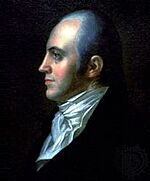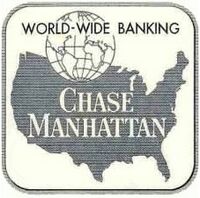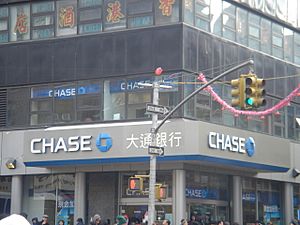Chase Bank facts for kids

The current logo, in use since 2005
|
|
|
Trade name
|
Chase Bank |
|---|---|
| Subsidiary | |
| Industry | Banking |
| Predecessor | The Manhattan Company |
| Founded | 1799 |
| Founder | John Thompson |
| Headquarters | , |
|
Number of locations
|
4,700 branches 17,000 ATMs nationwide 100 countries (2022) |
|
Area served
|
United States |
|
Key people
|
Jamie Dimon (Chairman and CEO) |
| Products | Financial services |
| Services | Retail Financial Services Card Services Commercial Banking |
| Revenue | US$124.54 billion (2022) |
| US$42.12 billion (2022) | |
| Total assets | US$4 trillion (2022) |
|
Number of employees
|
250,355 (2022) |
| Parent | JPMorgan Chase |
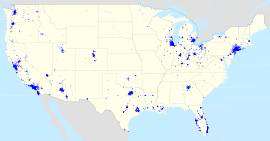
JPMorgan Chase Bank, N.A., doing business as Chase, is an American national bank headquartered in New York City that constitutes the consumer and commercial banking subsidiary of the U.S. multinational banking and financial services holding company, JPMorgan Chase. The bank was known as Chase Manhattan Bank until it merged with J.P. Morgan & Co. in 2000. Chase Manhattan Bank was formed by the merger of the Chase National Bank and the Manhattan Company in 1955. The bank merged with Chemical Bank New York in 1996 and later merged with Bank One Corporation in 2004 and in 2008 acquired the deposits and most assets of Washington Mutual. In May 2023, it acquired the assets of First Republic Bank.
Chase offers more than 5,100 branches and 17,000 ATMs nationwide and has 18.5 million checking accounts and 25 million debit card users as of 2023. JPMorgan Chase & Co. has 250,355 employees (as of 2016) and operates in more than 100 countries. JPMorgan Chase & Co. had assets of $3.31 trillion in 2022 which makes it the largest bank in the United States as well as the bank with the most branches in the United States and the only bank with a presence in all of the contiguous United States. JPMorgan Chase, through its Chase subsidiary, is one of the Big Four banks of the United States.
Contents
History
The Bank of The Manhattan Company (New York) was founded on September 1, 1799, and continued under that name until 1955, when it merged with the Chase National Bank, which was founded in 1877; the merged bank was called The Chase Manhattan Bank.
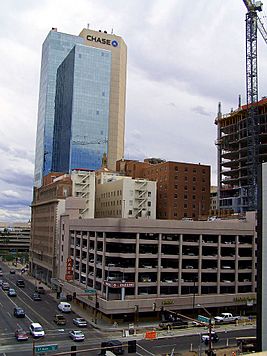
The Manhattan Company
Chase traces its history back to the founding of The Manhattan Company by Aaron Burr on September 1, 1799, in a house at 40 Wall Street:
After an epidemic of yellow fever in 1798, during which coffins had been sold by itinerant vendors on street corners, Aaron Burr established the Manhattan Company, with the ostensible aim of bringing clean water to the city from the Bronx River but in fact, designed as a front for the creation of New York's second bank, rivaling Alexander Hamilton's Bank of New York.
In 2006, the modern-day Chase bought the retail banking division of the Bank of New York, which then only months later merged with Pittsburgh-based Mellon Financial to form the present-day BNY Mellon.
Chase National Bank
Chase National Bank was formed in 1877 by John Thompson. It was named after former United States Treasury Secretary and Chief Justice Salmon P. Chase, although Chase (having died four years earlier) did not have a connection with the bank.
The Chase National Bank acquired a number of smaller banks in the 1920s through its Chase Securities Corporation. In 1926, for instance, it acquired Mechanics and Metals National Bank.
However, its most significant acquisition was that of the Equitable Trust Company of New York in 1930, the largest stockholder of which was John D. Rockefeller Jr. This made Chase the largest bank in the US and the world.
Chase was primarily a wholesale bank dealing with other prominent financial institutions and major corporate clients such as General Electric, which had, through its RCA subsidiary, leased prominent space and become a crucial first tenant of Rockefeller Center. They rescued that major project in 1930. The bank is also closely associated with and has financed the oil industry, having longstanding connections with its board of directors to the successor companies of Standard Oil, especially ExxonMobil, which are also part of Rockefeller holdings.
Merger as Chase Manhattan Bank
In 1955, Chase National Bank and The Manhattan Company merged to create the Chase Manhattan Bank. As Chase was a much larger bank, it was first intended that Chase acquire the "Bank of Manhattan", as it was nicknamed, but it transpired that Burr's original charter for the Manhattan Company had not only included the clause allowing it to start a bank with surplus funds, but another requiring unanimous consent of shareholders for the bank to be taken over. The deal was therefore structured as an acquisition by the Bank of the Manhattan Company of Chase National, with John J. McCloy becoming chairman of the merged entity. This avoided the need for unanimous consent by shareholders.
For Chase Manhattan Bank's new logo, Chermayeff & Geismar designed a stylized octagon in 1961, which remains part of the bank's logo today. It has been reported that the Chase logo was a stylized representation of the primitive water pipes laid by the Manhattan Company, but this story was refuted in 2007 by Ivan Chermayeff himself. According to Chermayeff, the Chase logo was merely intended to be distinctive and geometric, and was not intended at all to resemble a cross-section of a wooden water pipe. According to Chase, the sides of the octagon represent forward motion, while the blank space in the middle suggests progress originates from the center; and is a single unit made up of separate parts, like the bank. The bank included an asset management business called the Chase Investors Management Corporation. Under McCloy's successor, George Champion, the bank relinquished its antiquated 1799 state charter for a modern one. In 1969, under the leadership of David Rockefeller, the bank reorganized as a bank holding company, the Chase Manhattan Corporation.
The mergers and acquisitions during this period allowed Chase Manhattan to expand its influence over many non-financial corporations. A 1979 study titled "The Significance of Bank Control over Large Corporations" found that: "The Rockefeller-controlled Chase Manhattan Bank tops the list, controlling 16 companies." In 1985, Chase Manhattan expanded into Arizona by acquiring Continental Bank. In 1991, Chase Manhattan expanded into Connecticut by acquiring two insolvent banks.
Mergers with Chemical, J.P. Morgan
In August 1995, Chemical Bank of New York and Chase Manhattan Bank announced plans to merge. The merger was completed in August 1996. Chemical's previous acquisitions included Manufacturers Hanover Corporation, in 1991, and Texas Commerce Bank, in 1987. Although Chemical was the nominal survivor, the merged company retained the Chase name since not only was it better known (particularly outside the United States), but also the original charter of Chase required that the name be retained in any future business ventures. Hence, even today, it is known as JPMorgan Chase.
In December 2000, the combined Chase Manhattan completed the acquisition of J.P. Morgan & Co. in one of the largest banking mergers to date. The combined company was renamed JPMorgan Chase. In 2004, the bank acquired Bank One, making Chase the largest credit card issuer in the United States. JPMorgan Chase added Bear Stearns and Washington Mutual to its acquisitions in 2008 and 2009 respectively. After closing nearly 400 overlapping branches of the combined company, less than 10% of its total, Chase will have approximately 5,410 branches in 23 states as of the closing date of the acquisition. According to data from SNL Financial (data as of June 30, 2008), this places Chase third behind Wells Fargo and Bank of America in terms of total U.S. retail bank branches.
In October 2010, Chase was named in two lawsuits alleging manipulation of the silver market. The suits allege that by managing giant positions in silver futures and options, the banks influenced the prices of silver on the New York Stock Exchange's Comex Exchange since early 2008.

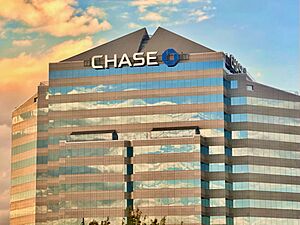
The following is an illustration of the company's major mergers and acquisitions and historical predecessors to 1995 (this is not a comprehensive list):
| Chase Manhattan Bank (merged 1995) |
|
||||||||||||||||||||||||||||||
Bank One Corporation
In 2004, JPMorgan Chase merged with Chicago-based Bank One Corp., bringing on board its current chairman and CEO Jamie Dimon as president and COO and designating him as CEO William B. Harrison Jr.'s successor. Dimon's pay was pegged at 90% of Harrison's. Dimon quickly made his influence felt by embarking on a cost-cutting strategy and replaced former JPMorgan Chase executives in key positions with Bank One executives—many of whom were with Dimon at Citigroup. Dimon became CEO in January 2006 and chairman in December 2006 after Harrison's resignation.
Bank One Corporation was formed upon the 1998 merger between Banc One of Columbus, Ohio and First Chicago NBD. These two large banking companies were themselves created through the merger of many banks. JPMorgan Chase completed the acquisition of Bank One in Q3 2004. The merger between Bank One and JPMorgan Chase meant that corporate headquarters were now in New York City while the retail bank operations of Chase were consolidated in Chicago.
The following is an illustration of Bank One's major mergers and acquisitions and historical predecessors (this is not a comprehensive list):
| Bank One (merged 1998) |
|
|||||||||||||||||||||
Washington Mutual
On September 25, 2008, JPMorgan Chase bought most banking operations of Washington Mutual from the receivership of the Federal Deposit Insurance Corporation (FDIC). That night, the Office of Thrift Supervision, in what was by far the largest bank failure in American history, seized Washington Mutual Bank and placed it into receivership. The FDIC sold the bank's assets, secured debt obligations and deposits to JPMorgan Chase Bank, NA for $1.888 billion, which re-opened the bank the following day. As a result of the takeover, Washington Mutual shareholders lost all their equity. Through the acquisition, JPMorgan became owner of the former accounts of Providian Financial, a credit card issuer WaMu acquired in 2005. The company completed the rebranding of Washington Mutual branches to Chase in late 2009.
Other recent acquisitions and expansions
In the first quarter of 2006, Chase purchased Collegiate Funding Services, a portfolio company of private equity firm Lightyear Capital, for $663 million. CFS was used as the foundation for the Chase Student Loans, previously known as Chase Education Finance. In April of that same year, Chase acquired the Bank of New York Co.'s retail and small business banking network. This gave Chase access to 338 additional branches and 700,000 new customers in New York, New Jersey, Connecticut, and Indiana.
In 2019, Chase began opening retail branches in Pittsburgh and other areas within Western Pennsylvania; this coincided with Bank of America starting a similar expansion within the area the previous year. Even though Chase entered the market organically as opposed to a merger & acquisition, they still had to receive approval from the Office of the Comptroller of the Currency to open branches due to Chase's size as a whole. Before Chase and Bank of America expanded its retail presence into the market, Pittsburgh had been one of the largest U.S. cities without a retail presence from any of the "Big Four", with locally based PNC Financial Services (no. 6 nationally) having a commanding market share in the area. Chase had previously considered buying National City branches from PNC that were required for divesture following that bank's acquisition of National City in 2009, but were instead sold to First Niagara Bank (since absorbed into KeyBank); it had been speculated that PNC intentionally sold the branches to a much smaller competitor due to not wanting to compete with a "Big Four" bank in its home market.
In August 2021, Chase announced that it was the first bank to have a retail presence in all 48 of the contiguous United States. The last state in the US to have a Chase branch was Montana, with the branch in Billings the first branch in the state.
Expansion outside the US
In September 2021, JPMorgan Chase entered the United Kingdom retail banking market by launching an app-based current account and Deposit account under the Chase brand. This is the company's first retail banking operation outside of the United States.
See also
 In Spanish: Chase Manhattan Bank para niños
In Spanish: Chase Manhattan Bank para niños


